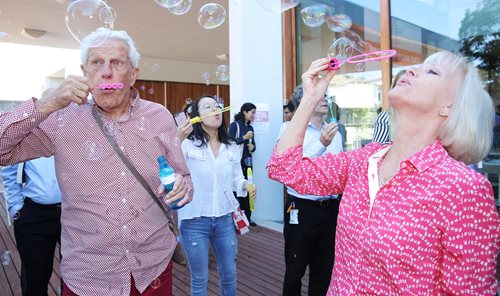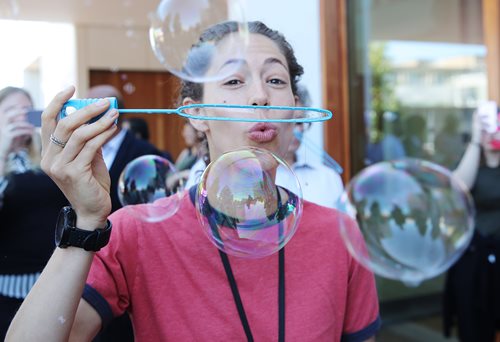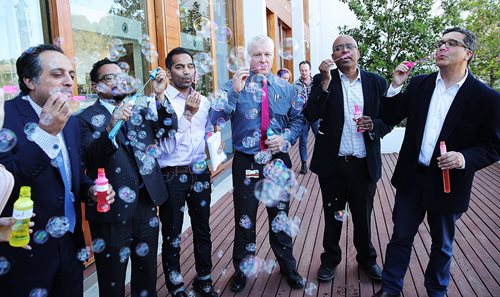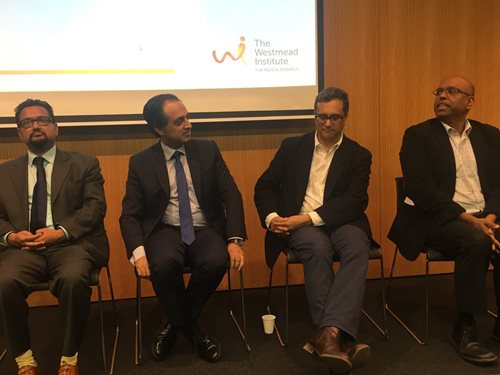April 5, 2018 Print
On Wednesday 28 March, the Westmead Institute of Medical Research celebrated World Bipolar Day through a community information seminar and symbolic bubble event.
People affected by bipolar disorder, their families, friends and the local community blew thousands of bubbles for ‘blow bubbles for bipolar’, an international initiative to raise awareness and help end the silence surrounding bipolar disorder.
The floating bubbles represented the ‘high’ or ‘manic’ moods a person with bipolar might experience, while a falling, bursting bubble represented the ‘low’ moods.
Helen Hadlow and Max Morris, who attended the event, both have a close connection to bipolar and other mental illnesses.
 Max Morris and Helen Hadlow blowing bubbles for bipolar
Max Morris and Helen Hadlow blowing bubbles for bipolar
Helen said her family and friends – including her four children and eight grandchildren – were her motivation for participating in the event.
“So many people close to me have been personally affected by mental illness. My sister has suffered from mental illness for most of her life and I have had friends attempt suicide.
“You never know if, or when, your family will be affected, so it’s important that we have a greater understanding of mental illness."
 Isabella Breukelaar from the Brain Dynamics Centre
Isabella Breukelaar from the Brain Dynamics Centre
The occasion was also marked with a panel discussion, featuring five leading clinicians and researchers in mood disorders.
 Dr Mayuresh Korgaonkar
Dr Mayuresh Korgaonkar
Dr Mayuresh Korgaonkar, panellist and Director of the Brain Dynamics Centre at the Westmead Institute, said the event was an important step towards raising awareness about the disorder among Western Sydney.
“Up to 1 in 50 of us will experience an episode of bipolar disorder in our lifetimes, so it’s surprising how little the everyday Australian knows about the condition,” he explained.
“The Brain Dynamics Centre wanted to raise awareness and shed some light on what living with bipolar is actually like to help break down the stigma associated with the illness.”
“Breaking down the stigma of bipolar is a community effort,” Dr Korgaonkar said.
“The bubble blowing event was so simple, but it got everyone together to understand bipolar. It was great to see the community and our researchers and students get involved.”
Bipolar disorder is a mental illness characterised by extreme variations in mood. A person with bipolar may go through phases of feeling ‘manic’, where they feel agitated and energetic, and phases of severe depression.
People with bipolar disorder may be misdiagnosed due to the complexity of their illness, and because certain symptoms, such as depressive phases, can mirror other illnesses.
Those affected have a greater risk of suicide compared to the general population, and may experience difficulties in maintaining relationships, and finding and keeping employment.
“Bipolar is complex and can really impact those who have it. But, it’s important to know that with the right treatment, we can successfully manage the disorder. We hope that message came across today,” Dr Korgaonkar concluded.
If you would like to get involved with the recruitment, as either someone with bipolar disorder, depression or a control, please contact Wendy Chen at wenting.chen@sydney.edu.au or 02 8627 3306.
 Members of the panel discussion joined the fun!
Members of the panel discussion joined the fun!
The panel discussion featured:
- Dr Prashanth Mayur, Senior Staff Psychiatrist of the Mood Disorders Unit in Cumberland Hospital
- Professor Gin Malhi, Executive and Clinic Director of the CADE Clinic
- Dr Mayuresh Korgaonkar, Director of the Brain Dynamics Centre and the Chief Investigator of the Bipolar Study at WIMR
- Dr Greg de Moore, Conjoint Associate Professor from the School of Medicine at Western Sydney University
- Dr Ramesh Vannitamby, Psychiatrist from Northside West Clinic, and staff specialist from Cumberland Hospital
 L-R: Dr Prashanth Mayur, Professor Gin Malhi, Dr Greg de Moore, Dr Ramesh Vannitamby
L-R: Dr Prashanth Mayur, Professor Gin Malhi, Dr Greg de Moore, Dr Ramesh Vannitamby